Fire Department Instructors Conference (FDIC) International 2022 was electrifying, literally and figuratively, pardon any puns intentional or otherwise. It seemed that every aisle in the Indianapolis Convention Center and attached Lucas Oil Stadium featured some product that was battery powered.
From full-blown fire apparatus to new circular saws and ventilation fans to rescue tools and even fire pumps, electricity was the new source of power for equipment. There were even a few traffic vests sporting batteries to power lights integrated in the garments for better visibility.
Of course, there were almost countless numbers of products being exhibited without batteries, including new lines of turnout gear and firefighter garments as well as training products, fire hose, and helmets, although some of those had integrated batteries to power nighttime headlamps.
Related Articles:
FDIC International 2022 Exhibitor Showcase: Sutphen
FDIC International 2022 Exhibitor Showcase: Silver Ships
FDIC International 2022 Exhibitor Showcase: Technimount System Inc.
There was a common theme to all the products, whether they were traditional, brand new, or improved, and that was to help keep firefighters efficient and, more importantly, safe and healthy.
Fire Apparatus & Emergency Equipment asked its advisory board members to write about the items they found most interesting and noteworthy. Following is a sampling of what they found.
Hand Grenades and Fire Balls
By Raul Angulo
I am not sure what it’s like for a child to grow up in a politically correct world, but when I was a kid, my friends and I always played Army, War, and Vikings. Nothing was more fun than throwing hand grenades, which were either rocks or clumps of grass attached to a ball of dirt packed within the root system. These dirt bombs track pretty good when you throw them.
Hand grenades are not a new concept in the fire service; in fact, glass grenade fire extinguishers were common from about 1870 to 1910. These hand-blown glass bulbs were originally filled with salt water; after 1900, they were filled with carbon tetrachloride (CTC). The glass bulbs were mounted on a bracket and a person in danger of fire could grab the glass “bomb” and toss it into the fire or the bracket could be mounted above the fire hazard, which activated automatically when the heat shattered the glass. Unfortunately, when CTC is exposed to high temperatures, it produces phosgene gas, so carbon-tet extinguishers were eventually phased out. Though the chemical extinguishing agent was dangerous to humans, the concept still had merit. I guess if you wait long enough, every idea circles back.

1 Elide Fire Extinguishing Balls with the air-compressed, rocket-launching bazooka. (Photos 1-3 by Raul Angulo.)
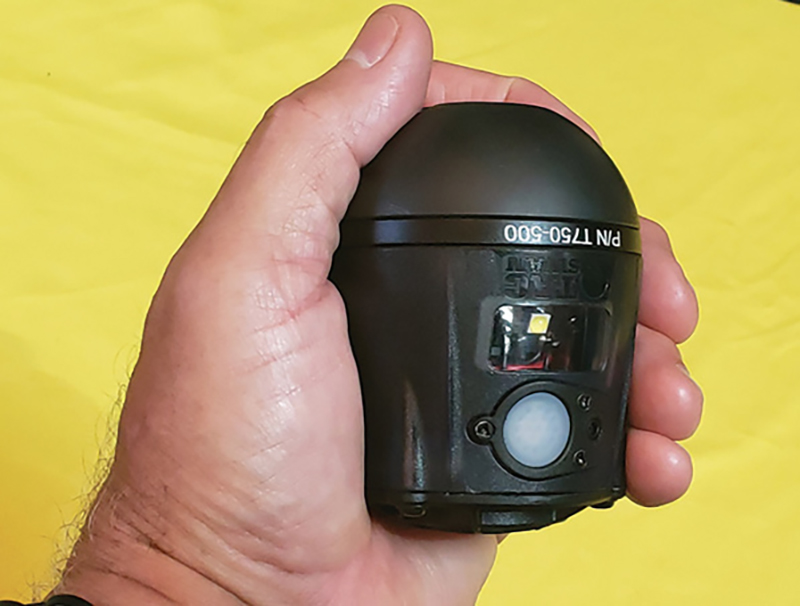
2 The T.E.D.D. fits in the palm of your hand like a hand grenade.
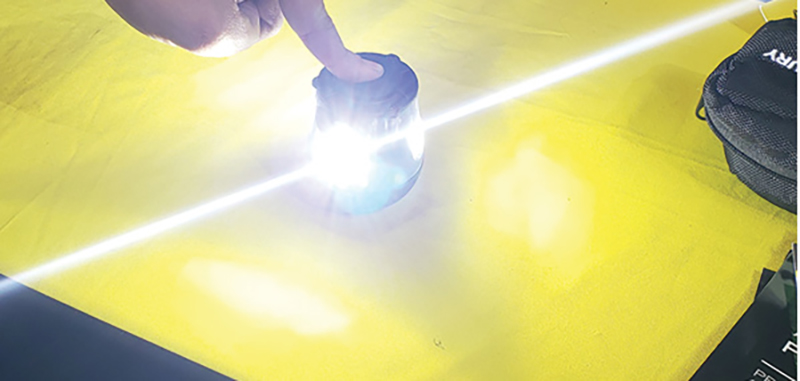
3 The white LED lights of the T.E.D.D. are 2,600 lumens and the alarm sounds at 120 decibels.
There were two hand grenades at FDIC. The first was the Elide Fire Extinguishing Ball®. This product of Thailand was invented by Phanawatnam (Woradech) Kaimart, a safety engineer. He was determined to find a fire extinguishing safety solution after the devastating Royal Jomtien Hotel fire that killed 91 people and injured 63 others on July 11, 1997. His solutions addressed the facts that traditional handheld fire extinguishers needed to be maintained, they must never lose their pressure, the fire must first be discovered, and the general public needs to get close enough to the fire for them to be effective. He produced the Elide Fire Extinguishing Ball (Fire Ball) a year later.
There are three types of Fire Balls that can be used for commercial, residential, auto, and marine applications. The blue-colored ball is for marine and auto engine compartments. It is four inches in diameter and weighs 1.5 pounds. The commercial and residential red-colored ball comes in two sizes. The six-inch-diameter ball weighs about three pounds, and the four-inch-diameter ball weighs 1.5 pounds.
The Fire Ball is basically a pressurized dry-chemical extinguisher that uses mono-ammonium phosphate as the extinguishing agent. It can be used on Class A, B, and C fires. It does not activate in elevated levels of heat, only when flames contact the surface fuses. The igniter at the top of the ball activates and explodes within 3 to 10 seconds, creating a large, dense cloud of dry chemical agent that displaces the oxygen and interrupts the chemical chain reaction of the fire tetrahedron. In the passive mode, the Fire Ball is mounted with a retaining clip directly above the fire hazard. In the active mode, the Fire Ball can be thrown, tossed, or rolled into the fire. It can even be dropped into a burning container by a drone or launched into the fire with a hand-held, air-compressed, rocket-launching gun—a bazooka.
The second grenade is the Tactical Electronic Distraction Device (T.E.D.D.) made by TacSwan and distributed by FoxFury. The T.E.D.D. can be used for riot control, SWAT, and active-shooter incidents. It is an illuminating/audio alternative to pyrotechnic flashbang devices. This durable, beefy unit, which is the size of a real hand grenade, fits in the palm of your hand, measures 3.2 inches, and weighs just over one pound. The lithium-ion rechargeable reusable unit is made from high-temperature polycarbonate, nylon, and steel. The weighted base is strong enough to break through single-pane windows and is self-righting when it lands. It is also submersible and waterproof up to 10 feet. The white LED lights are 2,600 lumens and the audio alarm blasts at 120 decibels. There are eight programmable light and sound modes and four programmable activation and delay modes. Trust me, the strobe light is blinding and the alarm is loud. Full operation is one hour in duration. Though primarily a piece of equipment for law enforcement, with all the riots and violent demonstrations that took place in the past few years, there are plenty of applications for the fire service to help keep their members safe during fire and EMS operations during a civil disturbance.
Rollover Stability
By Chris Daly
As I walked the show floor, I noticed a number of “aggressive”-looking brush or grass trucks that had single tires on the rear axle. Having grown up with most of the heavy-duty brush trucks having dual tires on the rear, I stopped at a few booths and started to ask some questions.
From what I gathered, tire technology has progressed to the point where we can now build a brush truck with a single tire on the rear axle. These tires are rated at nearly twice the weight rating as previous generations of tires, which allows fire departments to go from a dual rear wheel to a single rear wheel on certain types of apparatus.

4 A brush truck with a single tire on the rear axle. (Photos 4-5 by Chris Daly.)

5 By spreading out the track width of the vehicle, the vehicle should have a higher rollover threshold and thus increased rollover stability.
There are two advantages that I can think of right off the bat. First, the fear of getting a large branch, stump, or rock stuck between the rear wheels while driving off-road is no longer an issue. I recall spending an hour or so trying to get a large rock out from between the rear wheels of our 1975 Dodge Power Wagon during an active forest fire back in the day. Second, by spreading out the track width of the vehicle (which is measured to the center of the rear tire or the center of the rear duals), the vehicle should have a higher rollover threshold and thus increased rollover stability.
It’s Electric
By Ron Heal
Each year at FDIC, there is the question of what is the big new product that will be on display. In the fire apparatus world, the big news is electric—as in electric fire truck. At FDIC 2017, Rosenbauer unveiled a concept electric fire truck, stressing that an electric fire truck was only a concept but possibly one whose time could be coming (with no promise of a production model). Fast forward five years, and Rosenbauer had another unveiling, introducing the RTX fully electric fire truck—Engine 82, bought by the Los Angeles (CA) Fire Department.
The REV Group and Pierce displayed electric fire trucks as well. Electric fire trucks are certainly in their infancy, and there’s no way to predict the future. The fire truck manufacturing industry is coming onboard to join the auto, truck, delivery truck, and bus industries to go electric and go green.

6 Rosenbauer featured an electric pumper built for the Los Angeles (CA) Fire Department. (Photos 6-8 by Ron Heal.)

7 Pierce showcased its Volterra electric fire trucks in the Lucas Oil Stadium. Engine 8 is in service with the Madison (WI) Fire Department.
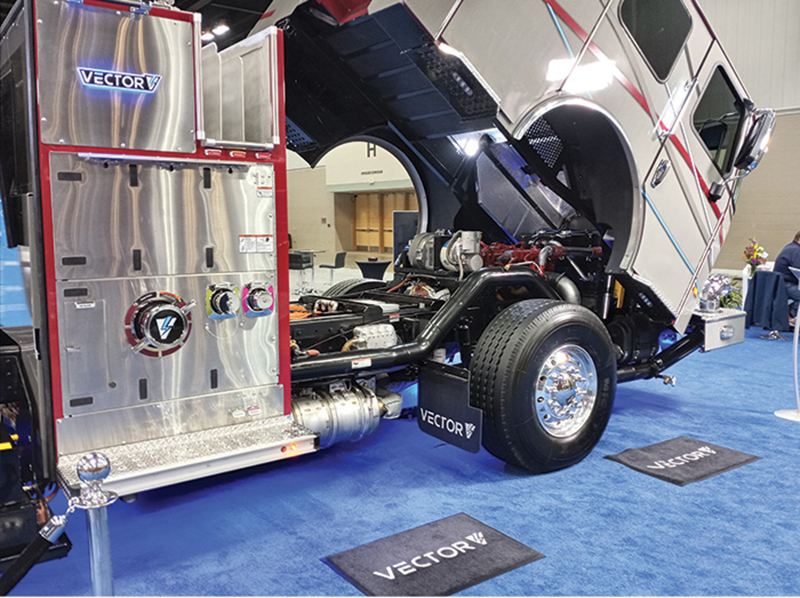
8 The Rev Group debuted its new electric pumper, the Volterra.
All three dominant apparatus manufacturers have invested heavily in time and research to develop the electric fire truck. This concept could be the biggest single change in the world of fire trucks since American LaFrance introduced the 700 series cab-forward fire trucks in 1947. Time will tell.
Pierce Manufacturing was at the show with an Enforcer™ Volterra™ 1,500-gallon-per-minute (gpm) pumper operating in test trials with the Madison (WI) Fire Department’s busy Station 8 since last summer. Chief (Ret.) Steven Davis worked with Pierce over the past two years and explained that the Pierce electric pumper operation exceeded his expectations. The Madison pumper displayed at FDIC was joined by a similar electric pumper sold to the Portland (OR) Fire Department.
The Rev Group, which includes E-ONE, Ferrara, KME, Smeal, Spartan, and Ladder Towers, introduced the Vector™, a North American-style, all-electric fire truck that responds, pumps, operates at the scene, and returns—all on electric power. There are zero emissions and zero greenhouse gases during operations. Roger Lackore, Pierce’s senior director of product development, heads the development of the Vector™. He made several presentations in the exhibit hall to introduce the Vector to attendees. There’s much to learn as electric begins to take a place in fire stations across the country.
National Foam Monitor
By William C. Peters
National Foam displayed its Terminator II high-capacity foam/water monitor. The unit uses a trailer with two ground outriggers for stability and can be easily maneuvered by two people for high-capacity water stream or foam application.
The self-educting nozzle is designed to deliver optimum performance with water or foam. The nozzle uses a water-powered jet pump for proportioning the concentrate and can operate with all types of foam.

9 National Foam’s Terminator II monitor. (Photo by William C. Peters.)
Using two 5-inch large-diameter hose water lines, it can operate at 75 pounds per square inch (psi) for a 1,299-gpm flow, 100 psi for a 1,500-gpm flow, and 1,677 gpm at 125 psi. Distance of the stream ranges from 176 to 227 feet.
The control position has a pressure/flowmeter and two large handwheel controls to adjust stream elevation and nozzle rotation.
The Next-Generation Pierce PUC Pumper
By Andy Soccodato
Since 2007, Pierce Manufacturing has designed, built, and sold the Pierce Ultimate Configuration™ (PUC) pumper. When the PUC™ was first revealed, it revolutionized the fire service, offering increased compartmentation, a short wheelbase, and a 1,500-gpm pump. This year at FDIC, Pierce introduced the next-generation PUC™ pumper, and it is obvious Pierce has stepped up its game.
The original PUC™ design employed a rear engine power-takeoff (REPTO) that powered the apparatus fire pump. The REPTO configuration meant that the driveline that ran between the rear of the motor and the apparatus fire pump always spun. On the original PUC™ pumper, an electric clutch was used to engage and disengage the apparatus fire pump for pumping operations. The major disadvantage of this design was that it could not produce enough torque to support fire flows of more than 1,500 gpm from a draft.
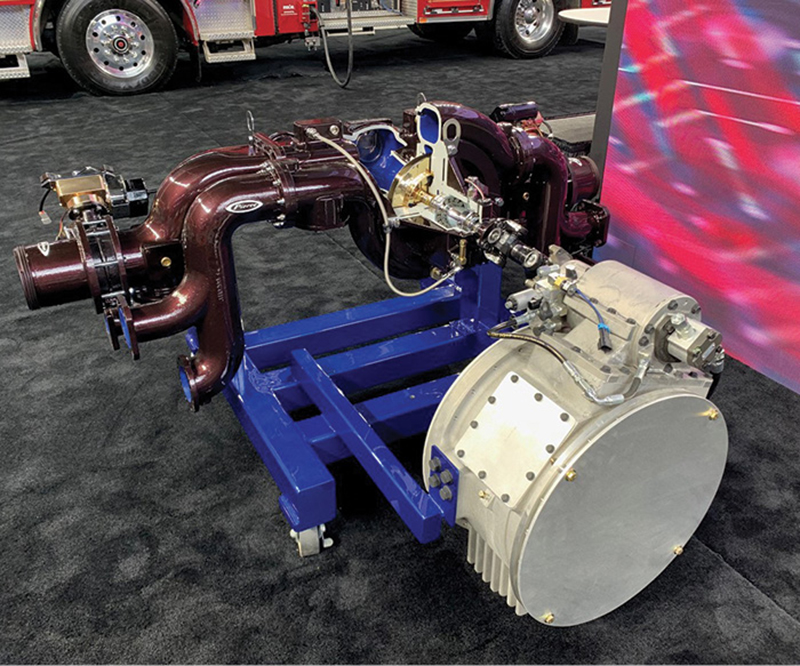
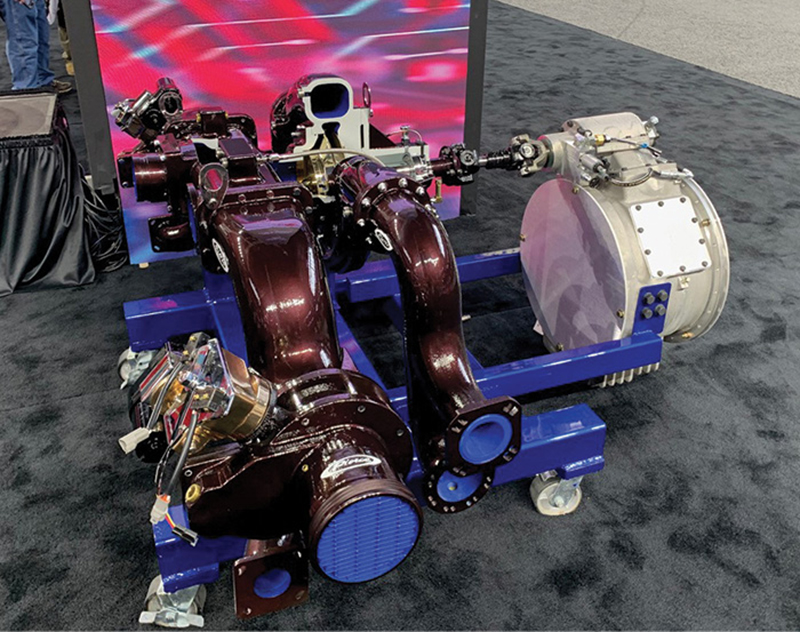
10 11 The next-generation PUC™ pump employs a redesigned pump transmission that allows this pump to achieve pump capacities of up to 2,000 gpm from a draft. (Photos 10-12 by Andy Socccodato.)
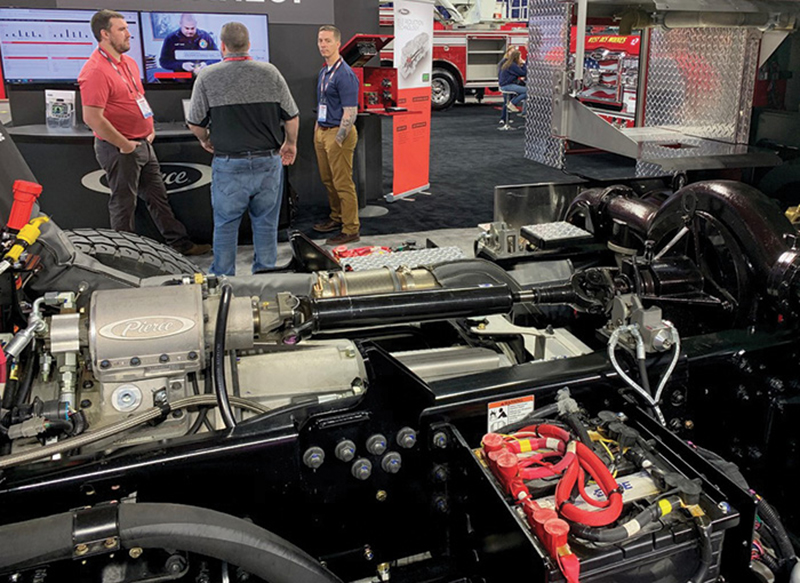
12 The next-generation PUC™ pump installed on a Pierce apparatus at FDIC. Not only does this configuration allow for a 2,000-gpm flow rate while drafting, but it also allows for ease of pump maintenance. Another major advantage of this design is that this redesigned pump transmission configuration causes the pump transmission driveline to spin only when the hydraulic clutch is engaged.
The next-generation PUC™ pumper offers the same advantages with regards to compartmentation and wheelbase while also offering a 2,000-gpm rated fire pump. Pierce, in conjunction with Darley, has achieved this higher pump rating through several unique design changes, the biggest being the introduction of the Pierce Integrated Pump Transmission.
The Pierce Integrated Pump Transmission is a total redesign of the way in which the PUC™ pump is powered. This new pump transmission is known as a “sandwich PTO” by Pierce engineers because it is located between the motor and the transmission of the vehicle, essentially sandwiched between the two. Compared to the previous electric clutch design of the PUC™ pump transmission, the Pierce Integrated Pump Transmission employs a hydraulic clutch configuration. This design allows the next-generation Pierce PUC™ to provide more torque output during pumping operations without sacrificing the overall length or wheelbase of the apparatus. In addition, because of where the new Pierce Integrated Pump Transmission is located and configured, the driveline that powers the pump spins only when the hydraulic clutch is engaged.
While the next-generation Pierce PUC™ still uses a single suction impeller, the unit does contain a larger impeller compared to the first-generation units. These pumps also incorporate a redesigned plumbing configuration feeding the discharge manifold that supplies the apparatus-mounted deck gun and individual preconnects. This new configuration is aimed at reducing the internal plumbing loss within the discharge side of the pump. On the intake side of the pump, the next-generation PUC™ pump also includes a larger tank-to-pump line. Previously, these pumps came standard with a 3-inch tank-to-pump line; the newly designed PUC™ pump comes standard with 4-inch tank-to-pump plumbing.
Although changes have been made to the traditional PUC™ design, options are still available that Pierce customers have come to love. PUC™ pumps are available in pumper, aerial, rescue, and tanker configurations. They are also available on Pierce Arrow XT™, Enforcer™, Impel™, Quantum™, and Velocity™ chassis. The next-generation PUC™ design will still allow the apparatus to have pump-and-roll capabilities. All of these options and qualities come together to make this apparatus a versatile option for today’s fire service.
Innovative Technology: Robotic Dog and Fire Training Prop
By Robert Tutterow
This year’s FDIC met and exceeded expectations as far as having great attendance, an abundance of product displays, and new product announcements. Here are a few of the new products that attracted my attention.
First, I have to mention Darley. This company continues to invest in developing many new products and is probably the number-one company when it comes to bringing new innovations to market, as was evidenced by a 14-page catalog on “Technology and Innovation.” A highlight of its booth this year was the introduction of a new technology division, which was highlighted by unmanned systems. The Ghost Robotics dog was arguably the biggest hit of the show. Other products included improvements to its EM 2,000-gpm pump to a 2,250-gpm pump and a new fully-electric pump. Two of Darley’s partners, FLAIM (virtual fire training) and Ascent Integrated Tech (firefighter locator and health monitoring system), were displaying upgrades to their cutting-edge products.
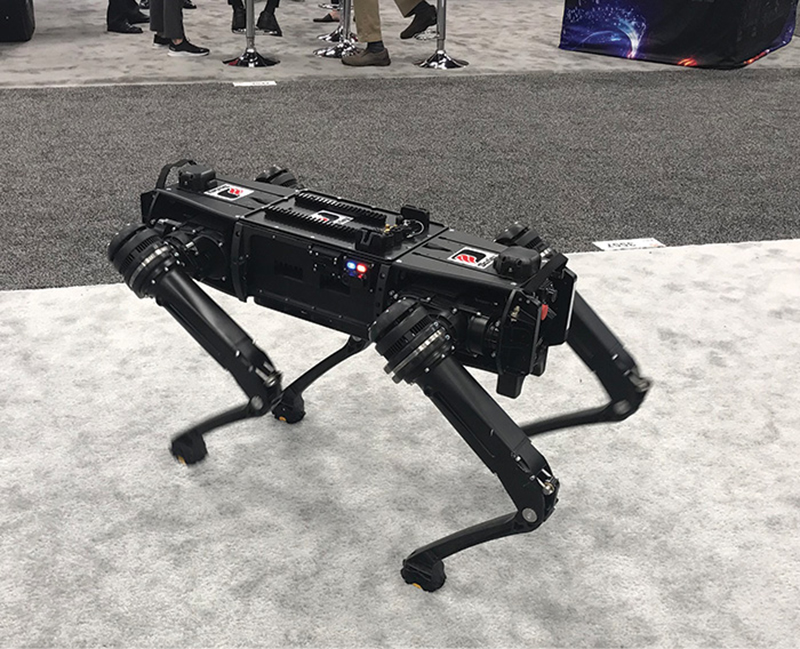
13 Darley’s Ghost Robotics dog. (Photos 13-14 by Robert Tutterow.)
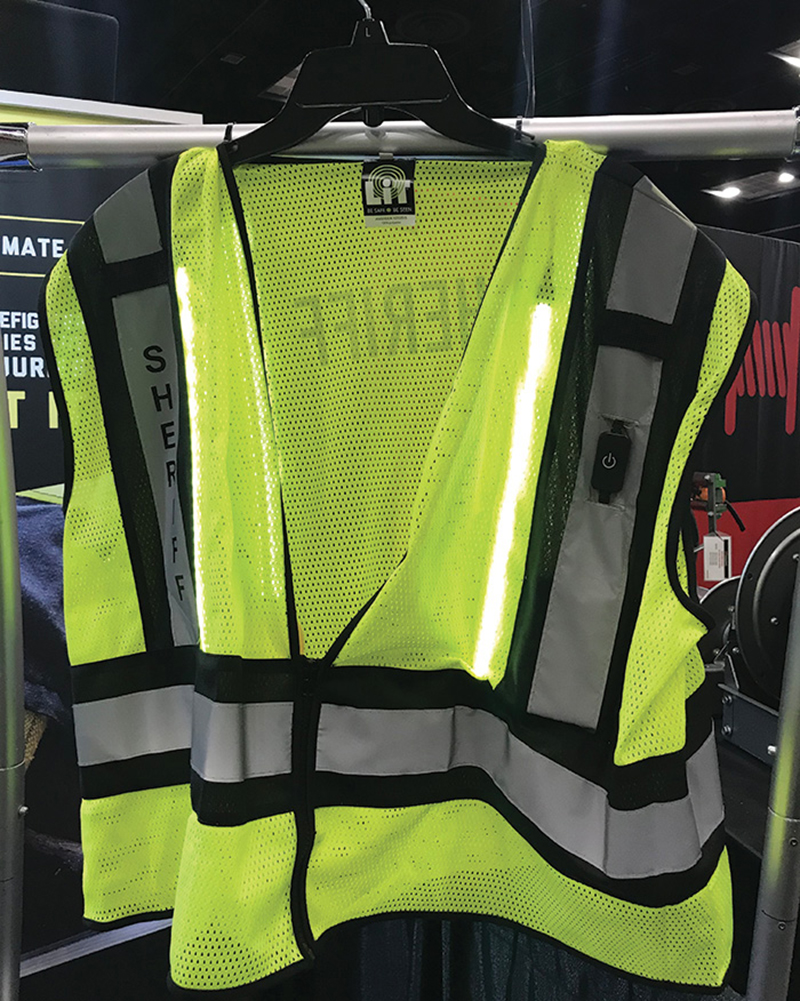
14 LiT’s illuminated safety vest.
Another new vendor that caught my eye was a portable fire training prop by Taylor’d Containers. The prop is made of shipping containers. It offers training in roof ventilation, confined space, forcible entry, bailout window, and more.
Viking Life-Saving Equipment had its new triple-certified personal protective equipment garment in its booth. The coat and trousers are certified to meet NFPA 1951 (tech rescue), 1999 (EMS), and 1977 (wildland) requirements with an option for blood-borne pathogen protection.
After reading a study on the hazards of bright flashing lights on roadway incidents blinding motorists so they do not see the emergency response personnel, I wrote that maybe it was time for the smart people to develop a safety vest with lighted retro-reflective striping. Serendipity. LiT was showing its illuminated safety vest. Not only is it illuminated, but the lighting is dimmable. This makes it practical for both daylight and nighttime work.
Electric Vehicles, Robots, Technology-Laden Equipment
By Alan M. Petrillo
The stars of the apparatus shown at FDIC 2022 were the electric vehicle (EV) fire trucks—Pierce Manufacturing Inc.’s Volterra® built for the Madison (WI) Fire Department and Portland (OR) Fire Department, Rosenbauer’s RTX built for the Los Angeles City (CA) Fire Department, and E-ONE’s Vector™ being built for the Mesa (AZ) Fire and Medical Department. Plenty of other new apparatus and equipment also made an appearance.
Sutphen Corp. introduced its newly-designed SLTDA 105 tractor-drawn aerial for the DeKalb County (GA) Fire and Rescue, the first Sutphen TDA built since the 1990s. The rig has 105 feet of vertical reach and 97 feet 7 inches of horizontal reach, can flow up to 1,500 gpm from the aerial waterway, and can carry up to 315 feet of ground ladders.
Pierce debuted its Arrow XT™ 100-foot heavy-duty low-profile steel ladder with a Command Zone™ Advanced Electronics System and Control Zone™ 52-inch pump panel.
SVI Trucks exhibited a stainless-steel walk-in heavy rescue truck for the Earleigh Heights (MD) Fire Department on a Seagrave Attacker SS two-door chassis and cab with a 24-foot body, a Command Light Knight slim light tower, HURST™ eDraulic® rescue tools, a Resolve Specialty Products LLC SpaceSaver mobile filling station, and an Onan Protec 30-kW generator.

15 Marion Body Works Inc. built a custom pumper for the Cornelia (GA) Fire Department with a Waterous 1,500-gpm pump, 750-gallon water tank, 30-gallon foam cell, and Waterous Aquis 3.0 foam system and installed all hand wheel valves on the discharges. (Photos 15-17 by Alan M. Petrillo.)

16 The electro-mechanical infinitely variable transmission built by Dana Spicer for use in Pierce’s electric fire trucks.

17 CMC exhibited and demonstrated its LEVR™ and BT LEVR™ Escape Systems.
Alexis Fire Equipment Company displayed a custom enclosed top-control pumper for Coon Creek (WI) Fire & Rescue on a Spartan Metro Star chassis and cab with a Waterous CXVC 20 single-stage 1,500-gpm pump, 1,000-gallon water tank, 20-gallon foam tank, and Waterous Aquis 3.0 foam system and also an 1,800-gallon super tanker for the Franklin Township (OH) Fire Department on a Kenworth T370 two-door chassis and cab with a Hale 1,500-gpm DSD150 pump and a Newton 10-inch square electric dump with a 36-inch manual swivel extension.
Emergency Vehicles Inc. (EVI) exhibited a walk-around heavy rescue truck for the Alamance County (NC) Fire Department on a Spartan Gladiator chassis and four-door cab with a 24-foot body featuring all transverse compartments. The rig has a 35-kW generator, a Will-Burt NighScan light tower, two Hannay electric cord reels, and two Hannay electric air supply hose reels.
W.S. Darley & Company launched a new Unmanned Systems, Metaverse & Robotics Division and displayed a Vision 60™ Quadrupedal Unmanned Ground Vehicle (Q-UGV™) built by Ghost Robotics. The unit is a mid-sized, high-endurance, agile, and durable all-weather ground drone that carries an array of payloads and, through its five cameras, manages unstructured terrain well.
Howe and Howe displayed the Thermite™ RSI firefighting robot, a remotely-operated tracked machine that can climb stairs, push vehicles from its path, and output a maximum of 1,250 gpm through its monitor. The company also showed the Thermite® EV2, an all-electric firefighting robot that provides real-time situational awareness with recording capabilities.
MSA debuted new features to its Lunar platform, including an auto-acknowledge Personnel Accountability Report (PAR) check that doesn’t require radio traffic and a map view for the incident commander’s (IC’s) fireground monitor that shows the status of firefighters (green=okay, red=alarm) and the locations where they enter buildings. The enhancement allows for satellite, topographic, and street views. MSA also displayed a FOTOKITE actively-tethered drone that provides situational awareness for ICs through MSA’s FireGrid monitor. The FOTOKITE carries both thermal and optical cameras.
In other technology developments, Lakeland Industries introduced BodyTrak®, a monitoring system that tracks a firefighters’ vital signs—heart rate, temperature, and fatigue state—and also detects falls.
New Technology for Genesis EForce Extrication Cutters
By Bill Adkins
Genesis Rescue Systems has a strong reputation for being on the cutting edge of technology with its extrication equipment. When Genesis introduced the EFORCE battery-powered extrication tools using Milwaukee batteries about a decade ago, it showed the world it was serious about keeping up with or exceeding competitors’ technology. At FDIC International 2022, Genesis proved once again it was at the forefront of battery-powered technology.
First Genesis introduced the F7 cutter with the capability to be submerged in salt water, dirty water, or fresh water without compromising the Milwaukee M18 battery platform. The technology provides a watertight cover that completely encapsulates the M18 battery. This gives firefighters the confidence of operating the battery-powered tools in almost any condition imaginable with no worries of ruining tools do to cutting in or around water.

18 The Genesis SLI untethered version of its battery-powered extrication tools. (Photo by Bill Adkins.)
The F7 cutter also has a redesigned cutting blade used for cutting F7 grade material. According to Genesis, the new blades have a wider support surface at the rear for increased stability, two full-length teeth for better piercing into high-strength steels, and new blade geometry that provides a more acute angle to create a sharper blade. The U-shaped blade allows for better grasp on vehicle pillars.
Another technology Genesis produced is the SLI untethered version of its battery-powered extrication tools. This gives the user the ability to see if max pressure is reached, service is needed, if the unit is in theft mode, or when the unit is in training mode.
According to Genesis, the max pressure feature indicates when max pressure is reached. This allows the user to determine if the cut is complete or a reposition is needed to complete the cut. The service light indicates the need for service through a smartphone app. The theft mode, through a smartphone app, allows the user to set a geographical location or department area to prevent loss or theft. Training mode allows the training officer or company officer to control the tool’s power for safety concerns.
Additional features include LED lights that can be adjusted from 0-100% in five steps; an on/off switch that also allows the tool to automatically shut off if not in use for 30 seconds; and a mobile app via smartphone that allows crews to see real-time tool information such as electronic temperatures, motor speed, current, pressure, voltage, output, battery life, battery health, and the ability to control the lights and on/off button.
Safety and Health
By Richard Marinucci
Knowing that there was not enough time to see everything, I focused my attention on items related to firefighter safety and overall health. The good news is that there are many people, companies, and products looking for ways to improve firefighter wellness based on the threats in the modern fire service. Many of these products are following the trends in society and those discovered through study and research. You can see the trend toward battery power for most everything. This offers benefits and an opportunity for departments to look at the way they do things. The improvements in power offer many more options, and the demonstrations at the show helped to provide insight and information for departments to make good decisions. As with any changes or new products, evaluate them to see if the time is right and the product meets the needs of your department.
I am most impressed with the various products and services looking to improve firefighter health and safety. I saw products intended to reduce the risk of cancer, from personal applications to items intended to help with decontamination. There were those looking at mental health issues. There were other products trying to increase effectiveness on the fireground while adding some sense of redundancy as a backup should something go wrong. The point is that there are many innovations; not all will end up as part of the mainstream, but some will gain traction and help firefighters.
Vehicle Rescue/Extrication
By Carl J. Haddon
Probably the two most exciting new products that I saw at FDIC 2022 were both vehicle rescue and extrication related. The first was a new vehicle extrication prop from FireVent, LLC. This prop allows for extrication tool time when actual vehicles are not available. This prop allows for “door pops,” hinge cuts, dash displacement, and patient extrication.
The other innovation I saw was the new battery-powered F7 rescue cutter from Genesis Rescue Systems. Housed on the EFORCE SLI platform, this tool is advertised as the first rescue cutter that can handle the National Fire Protection Association’s highest and toughest “F” material category.
New Innovations from Task Force Tips
By Andy Soccodato
Being the water nerd that I am, FDIC always gives me the opportunity to look for tools and configurations that make moving water more efficient and safer. Two products struck me as extremely innovative at the Task Force Tips (TFT) booth this year: the EXTEND-A-GUN VP™ and the SHO GAUGE™.
The EXTEND-A-GUN VP™ is designed to increase firefighter safety when employing an apparatus-mounted deck gun. TFT has historically manufactured a manual version of the EXTEND-A-GUN™. This tried-and-true style of adjustable deck gun plumbing has enabled fire departments all over the country to extend their monitor high enough to reach over the cab/body of the apparatus for exterior operations. A single firefighter “blitz attack” operation has proved to be complicated with the manual version of the EXTEND-A-GUN™ because the operator would first have to climb up on the rig to extend the monitor into position, climb back down to charge the monitor, then climb back up on top of the apparatus to operate the monitor.
Some fire departments have elected to retrofit their apparatus with gate or ball valves on the discharge of the deck gun to allow the pump operator to charge the monitor from the pump panel, then climb up and open the gate/ball valve to put water on the fire. The problem this creates is that a manual version of the EXTEND-A-GUN™ cannot be raised when the monitor is charged. The EXTEND-A-GUN VP™ solves this problem for firefighters.
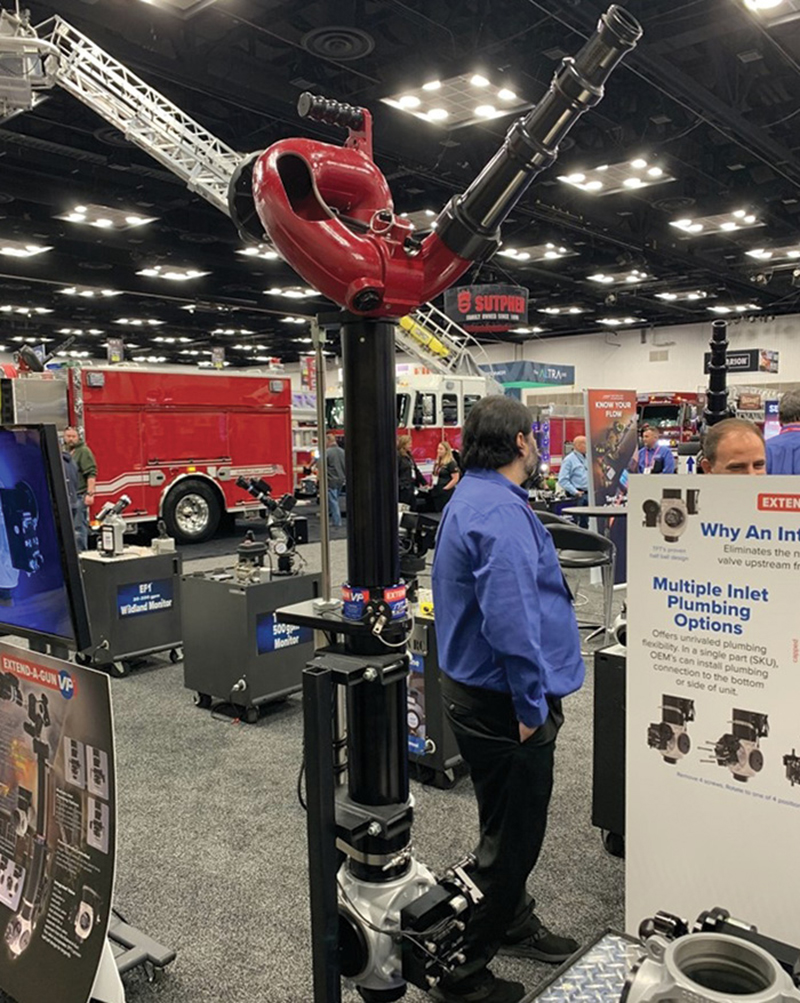
19 The EXTEND-A-GUN™ fully extended. (Photos 19-20 by Andy Soccodato.)
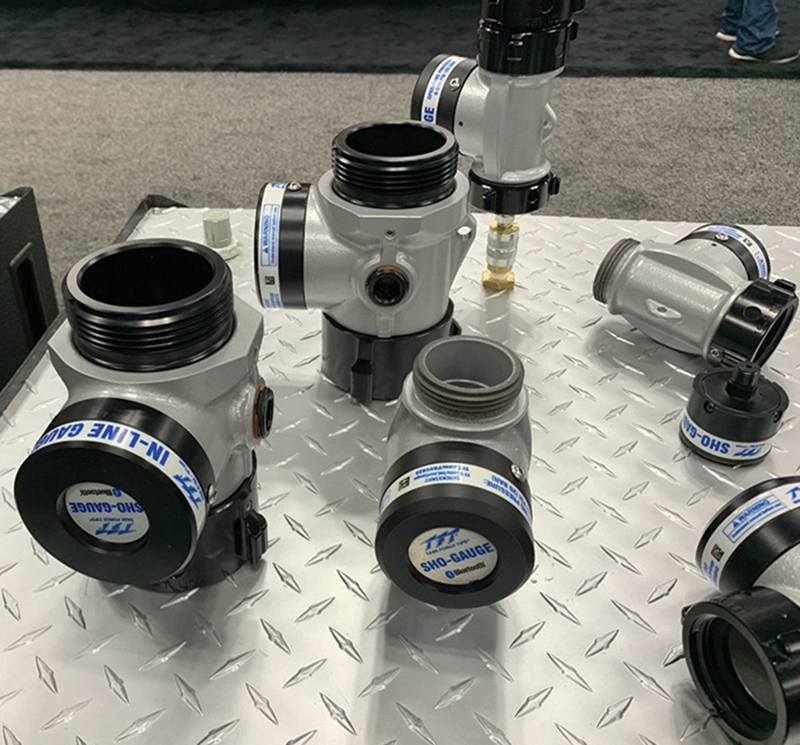
20 The SHO GAUGE™ uses a pressure transducer and Bluetooth technology.
This version of TFT’s older product uses an air-actuated valve to lift the extension plumbing for the deck gun from a remote location, usually located at the pump panel. The EXTEND-A-GUN VP™ is equipped with an integrated valve that serves as the primary discharge valve for the deck gun assembly. This allows the operator to either open the discharge feeding the deck gun from either the pump panel or the dunnage area of the rig. For “blitz attack” operations, the operator can extend the gun from the pump panel, climb on top of the apparatus, and then open the deck gun from on top of the rig. This configuration helps to reduce the loss of water during a “blitz attack” while simultaneously simplifying plumbing arrangements.
To ensure the safety of firefighters during these operations, the EXTEND-A-GUN VP™ has a series of interlocks that prevent the monitor from extending or retracting while water is flowing through the deck gun. If the operator fails to first extend the monitor, an interlock prevents the discharge valve from being opened. Conversely, if the monitor is extended and flowing water, the air-actuated control valve is disabled and will not allow the monitor to retract.
The SHO GAUGE™ is the second product introduced by TFT using Bluetooth technology, the first being the SHO FLOW™ Bluetooth flowmeter. This new product uses a pressure transducer and Bluetooth technology to give firefighters an accurate real-time pressure reading using the associated SHO GAUGE™ app.
At the show, this product was featured in 1½- and 2½-inch gauge configurations. However, this product could also be used in place of an analog gauge on a pitot tube. Since the pressure transducer used is equipped with ¼-inch National Pipe Threads (NPT), this product can be put virtually anywhere a pressure reading is desired.
. . .
FDIC is the premier training conference and exhibition in North America where many manufacturers debut new products. Next year’s show will be held in Indianapolis April 24-29, 2023. Start making plans now so you can see the latest in firefighting equipment and technology and find out why it is nicknamed “The Greatest Show on Earth.”

